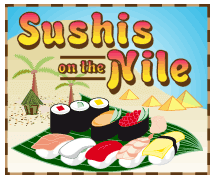This is the lesson attached to the Chinese learning game Sushis on the Nile. Get familiar with common Chinese characters with this introduction to Chinese learning! Play the FREE version of the game or join us and get the full version!
Although China appears to the outside world as a unified country with one language, there is actually no such thing as one Chinese language but many Chinese dialects.
Mandarin (the standard usually referred to as Chinese) is also known as Putonghua, Hanyu, or Guoyu. Putonghua means Common Language, Hanyu Language of the Hans and Guoyu Language of the Nation. All three are synonymous.
The Common Language refers to a modern standard Chinese that is very different from the dialect spoken in Shanghai (Hu dialect) or in Hong Kong (Cantonese) for example. Nevertheless, most Chinese people will understand Mandarin or are able to guess the general meaning of a speech in Mandarin.
The term Language of the Hans comes from the fact that the Hans are the principal ethnic group of China, constituting about 93 percent of the population.
The Chinese writing system was developed in China in the second millennium BCE. The basic system of writing Chinese has not changed since that time, although the set of characters used, their specific shapes, and the technologies involved have developed over the centuries.
You need to know about 4,000 characters to be functional in written Chinese. A character almost always corresponds to a single syllable that is also a morpheme, the smallest combination of meaning and phonetic sound in Chinese.
Example dà big
Chinese characters represent words and are made out of simple basic strokes.
Example has 3 strokes, has 14 strokes.
Simply written characters are not necessarily common words, and complex-looking characters may designate a very useful and common character that you need everyday.
Example means I / me, whereas means concave
Some characters are composed of radicals (or keys), which are sets of strokes. Different characters very often use the same radicals, and therefore you might get confused, thinking they are the same character.
Example and same FIRE radical on the left part of their character.
Chinese characters come in 2 flavors: simplified and traditional. However, whether simplified or traditional, the overall silhouette of the character is usually the same.
Example is the simplified version of
Simplified characters are used in most parts of the People’s Republic of China (PRC) and Singapore, and traditional ones are used predominantly in the Hong Kong and Macao SARs (Special Administrative Region), Taiwan, and overseas Chinese communities.
Obviously, the more strokes there are in a Chinese character, the more difficult it is for you to memorize it.
The best way to go about memorizing the more complex ones is either to identify the radicals (or keys) that form the character, or to recognize the silhouette or general shape of a character as you would an object or animal.
The Chinese writing system was created while the Egyptians were developing hieroglyphs. Like hieroglyphs, the Chinese characters are a combination of pictograms, ideograms, and signs that indicate sounds.
Because the Chinese writing system changed very little during the 4,000 years of its existence, Chinese is much closer to Egyptian hieroglyphs than to any other language on Earth.
